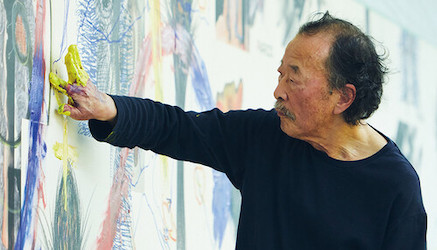
Seitaro Kuroda (黒田征太郎; b. 1939). A contemporary Japanese artist.
Born in Dotonbori, Chuo-ku, Osaka in 1939. Moved to Nishinomiya City, Hyogo Prefecture after birth and grew up there.
Painter and illustrator. After working as a crew member of a U.S. military ship, he established K2 with Hironori Nagatomo in 1969, and since 1992 has had a studio in New York, where he has worked extensively both in Japan and abroad.
Born 1939 in Osaka, Japan, Kuroda is an artistic phenomenon. He has revolutionized art in Japan. Kuroda has kept authentic art styles, such as live painting, fresh for over fifty years. His live painting refers directly to Tachism, also called Art Informal or Action Painting. Seitaro Kuroda has mastered that style fabulously, and how well it fits the culture of Japan.
Kuroda’s type of work has over the 20th century grown from the insights of painters like Henri Matisse, Hans Hofmann, Georges Mathieu, Jackson Pollock, Sam Francis and many others. French painter Georges Mathieu started Tachism in 1950 and came to Japan as early as 1954 and 1957, even before becoming Europe’s leading figure in Action Painting. Mathieu receives respect in the first proclamation of the famous Japanese concrete art movement Gutai, 1954-1972.
Many years later the seeds of this style grew successfully on Kuroda’s talents. Even though Seitaro Kuroda started his design group K2 with Keisuke Nagatomo only in 1969 and began his live paintings as late as the 1980s, the inspiration of Tachism or Action Painting may have come to him directly. Kuroda’s posters have been selected twice for New York’s MOMA collection.
He started “PIKADON PROJECT” in 2004, moved his base to Kitakyushu City in 2009, and has been actively engaged in live painting and mural painting, etc. Since the 3.11 disaster, he has often traveled to the Tohoku region to work as an artist. Since the 3.11 disaster, he has often traveled to Tohoku and put all his energy into his work as an artist.
Seitaro Kuroda (1939-present)
Seitaro Kuroda, born 1939 in Osaka, Japan, is an artistic phenomenon. He has revolutionized art in Japan, one says. It is indeedexceptionalhowMr.Kurodahaskeptanauthenticartstyle,likelivepainting,freshforoverfiftyyears. Hislive painting refers directly to Tachism, also called Art Informal or Action Painting. Seitaro Kuroda has mastered that style fabulously,andhowwellitfitsthecultureofJapan. ThisOctoberNewYorkhastheprivilegeofseeingmasterpainter Seitaro Kuroda live in the program Pikadon Project at The Kitchen.
Mr. Kuroda’s type of work has over the 20th century grown from the insights of painters like Henri Matisse, Hans Hofmann, Georges Mathieu, Jackson Pollock, Sam Francis and many others. French painter Georges Mathieu started Tachism in 1950 and came to Japan as early as 1954 and 1957, even before becoming Europe’s leading figure in Action Painting. Mathieu receives respect in the first proclamation of the famous Japanese concrete art movement Gutai, 1954-1972. American painter Sam Francis lives in Paris in the early 1950s picks up Tachism and moves to Japan in 1957. Many years later the seeds of this style grew successfully on Kuroda’s talents. Even though Seitaro Kuroda started his design group K2 with Keisuke Nagatomo only in 1969 and began his live paintings as late as the 1980s, the inspiration of Tachism or Action Painting may have come to him directly.
It is breathtaking to see Seitaro Kuroda at work. In itself it is amazing how a painter could keep his hand as fresh as Seitaro Kuroda did over the thirty-five years of his career. In his first years as a painter thousands of works, also for posters and printedmatter,wereproduced. PostersbyMr.KurodawereselectedtwiceforNewYork’sMOMAcollection. Healso produced many wall paintings.
When his live painting performances started in the 1980s Seitaro Kuroda could be seen with music groups on stages throughoutJapanandabroad. In1994thefirstfilmwithtwelveanimatedstorieswasmadeandothersfollowed.Anew animated movie as well as a documentary film are scheduled for August 2005, the 60th post-war memorial event in Hiroshima. On top, books, CDs DVDs with the dreamy or direct drawings of Seitaro Kuroda are being produced year by year. His language is universal.
This October, Seitaro Kuroda joins Pikadon Project on Monday 03 October 2005, at 20.00 hours. At The Kitchen a live painting by Seitaro Kuroda to live music of Toshinori Kondo is presented. The event will bring back the intuitive spontaneity, joy and lust for freedom of the 1950s. It is crucial for Seitaro Kuroda to accelerate speed to give vent to his subconscious.Workingblindlyscenesandpersonscomeandgofromhiscanvas. Theprinciplehereistocreatefrom intuition.Impulsivegesturesbringlifetothematerialofpaintandsound. Thechancetoexperiencethispuremétierof impressionist painting and sound is unique. Seitaro Kuroda uses paint and movement in balance with his vitality and talents. A film of his inner visuals plays before your eyes. The thin sounds from the trumpet of Toshinori Kondo bring more shine and thrill to the ever-changing images.
On video the interaction of the two artists is endless. When Seitaro Kuroda finds a street, sidewalk or embankment to paint his fresh figures on, in that same moment Toshinori Kondo finds some strange sound-experience to embellish the just drawn figure.ItissaidthatActionPaintinglaidthefoundationforHappening,Fluxus,andConceptualArt. ToshinoriKondo’s music background lies in Fluxus. Young Kondo especially loved John Cage, for some the grandfather of Fluxus. To see and hear Kuroda and Kondo work together offers an unforgettable mix of experiences to our six senses. It translates into a dream of vitality, love, friendship, change, warmth, and new visions at hand. Originally the theory behind this style was to run societies by the creativity of artists. Georges Mathieu referred to economist John Kenneth Galbraith for that. The ideals have meanwhile spread widely. To see Seitaro Kuroda at work in New York and London is welcoming back a cosmopolitan art style of great impact.
For the titles of Pikadon Project by Seitaro Kuroda: www.pikadon.jp, Or English site, www.pikadon.org.